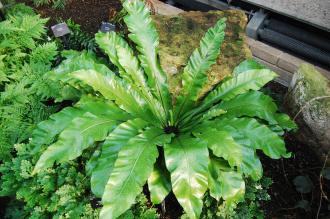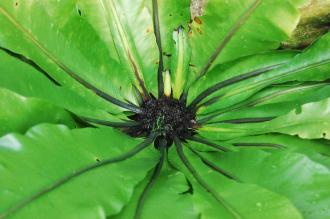
Asplenium nidus (16/01/2016, Kew Gardens, London)
Position: Bright indirect light
Flowering period: N/A
Soil: Moist, well drained
Eventual Height: 60cm
Eventual Spread: 60cm
Hardiness: 11, 12, 13
Family: Aspleniaceae
Asplenium nidus is an epiphytic or terrestrial evergreen fern with rosette forming habit. Its mid green glossy leaves consist of undivided fronds with a black mid rib, each are strap shaped with entire margins, are up to 90cm long and 15cm across. On the underside of some leaves sori are arranged in rows perpendicular to the rachis and are clusters of sporangia structures, these produce spores.

Asplenium nidus Leaf (16/01/2016, Kew Gardens, London)
Asplenium nidus, commonly known as Bird’s Nest Fern or Nest Fern, is native to east tropical Africa, east tropical Australia and tropical south east Asia. In its native habitat it grows as an epiphyte or terrestrial plant in humid tropical forests.
The etymological root of the binomial name Asplenium is derived from the Greek a meaning ‘without’ and splen meaning ‘spleen. Nidus is from the Latin meaning ‘nest’.
The landscape architect may find Asplenium nidus useful an attractive evergreen foliage houseplant, suitable for a bright position. This plant requires a humid atmosphere.
Ecologically, Asplenium nidus is of little value to UK wildlife.
The Royal Horticultural Society have given Asplenium nidus their prestigious Award of Garden Merit in 1993.

Asplenium nidus Crown (16/01/2016, Kew Gardens, London)
Asplenium nidus prefers moist, fertile, humus rich, well-drained soils. It prefers a neutral to acid pH of soil.
When maintaining Asplenium nidus as a houseplant its soil should be watered regularly to ensure it never dries out. A humid environment should be provided for this plant. Its preferred active growing temperature rages from between 16ºc to 24ºc, it will tolerate a temperate as low as 10ºc. Feeding with weak fertiliser solution should be carried out once every two weeks during the growing season. Scale insect and eelworms may attack this plant.

Landscape Architecture

